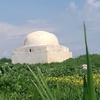Disclaimer
This entry contains information known to us from a variety of sources but may not include all the information currently available. Please be in touch if you notice any inadvertent mistakes in our presentation or have additional knowledge or sources to share. Thank you.
Archive
Tomb of Yehudah ben Betera and Second Cemetery, Qamishlo (Qamishli), Syria
Tomb of Yehudah ben Betera near Qamishlo (Qamishli, القامشلي, Qamişlo, קמישלי), Syria.
Yehudah Ben Betera (Bathyra) lived sometime before the destruction of the temple in Jerusalem (70 AD), approximately between the years of 50 BC and 50 AD. The Rabbi is known for his scholarly accoplishments which included setting up an ancient college and being cited in the Talmud. In the 12th C a synagogue was built in his hometown of Nisibis (Nusabayn) in his honor. Historically, Ben Betera maintained a strong legacy and presence in this municipality due to the popularity of religious pilgramges to his Tomb. Nisbis (Nusabayn) and Qamishli, the present day site of his Tomb, was one city up until the post-WWI division of of the Ottoman Empire. As a result, Nisibis (Nusabayn) is considered part of Turkey, while Qamishli is within the Syrian borders. The area's Jewish population fled from Nisibis to Qamishli during this split. Numbering 3000 in 1930, the population slowly dwindled, to 800 in 1963, and finally reaching 0 in the 21st century. The decline was mostly due to the Zionist and Anti-Zionist movements.
Description
The synagogue has a hole in the roof and a hole in a side wall, presumably because people wanted to get in to pillage valuables. Following the Turkish destruction of the first cemetery in 1985, the area around the tomb was used as a cemetery.
Sources
Joseph Samuel visited in 2015 and provided pictures.










